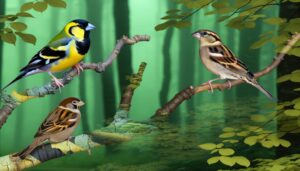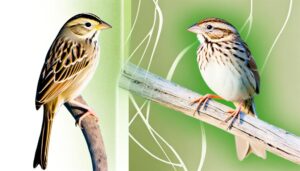Blue Jay Vs Sparrow: A Comparison Guide
Blue Jays and Sparrows vary considerably in size, appearance, and behavior. Blue Jays measure 9-12 inches and feature vibrant blue, white, and black plumage.
In contrast, Sparrows are smaller, 4-6 inches, with brown and gray tones. Blue Jays prefer woodlands and oak nests, while Sparrows adapt well to urban environments.
Their diets reflect adaptations: Blue Jays are omnivorous, while Sparrows mainly eat seeds and insects. Vocalizations differ too, with Blue Jays’ loud calls contrasting Sparrows’ melodic chirps.
These distinctions underscore their unique ecological and social roles. Explore further to grasp their intricate survival strategies and interactions.

Key Takeaways
- Blue Jays are larger (9-12 inches) with vibrant blue, white, and black plumage, while Sparrows are smaller (4-6 inches) with brown and gray tones.
- Blue Jays thrive in woodlands and oak trees, whereas Sparrows adapt well to urban environments and man-made structures.
- Blue Jays are omnivorous, eating nuts, seeds, and small vertebrates; Sparrows are primarily granivorous, consuming seeds and insects.
- Blue Jays produce loud calls for social interactions and territory defense, while Sparrows have simpler, melodic chirps for social communication.
- Blue Jays contribute to seed dispersal and forest growth; Sparrows help in natural pest management and support habitat formation.
8 Aspects: Blue Jay vs. Sparrow
| Aspect | Blue Jay | Sparrow |
|---|---|---|
| Size | Larger, around 9-12 inches (23-30 cm) long | Smaller, typically 4.5-8 inches (12-20 cm) long |
| Coloration | Bright blue feathers with white and black markings | Usually brown or gray with streaks or patches of white or black depending on species |
| Behavior | Highly territorial, intelligent, known for mimicking sounds | Social within species, territorial during nesting season, aggressive towards smaller birds |
| Diet | Omnivorous: seeds, nuts, insects, and small animals | Primarily granivorous: seeds, grains, with occasional insects |
| Habitat | Woodlands, suburban gardens, parks | Open areas, grasslands, forests, and urban environments |
| Nesting | Builds nests in trees; may defend fiercely against predators | Builds nests in bushes, trees, or man-made structures; sometimes invades other birds’ nests |
| Aggression Level | Can be aggressive, especially towards smaller birds | Aggressive mainly during breeding and food competition |
| Vocalization | Loud and varied calls, including mimicry of other species and animals | Constant chirping; simpler songs compared to Blue Jays |
Physical Characteristics

Comparing the physical characteristics of Blue Jays and Sparrows reveals distinct differences in size, plumage, and beak shape.
Blue Jays, larger in size, typically measure around 9-12 inches in length, while Sparrows are smaller, averaging 4-6 inches.
The Blue Jay’s plumage is vibrant, showcasing a mix of blue, white, and black, whereas Sparrows exhibit more muted tones of brown and gray, aiding in camouflage.
Beak shapes also differ; Blue Jays possess a strong, slightly curved beak suited for cracking nuts and seeds, while Sparrows have a shorter, conical beak ideal for foraging small seeds and insects.
These physical distinctions underscore their adaptations to varied ecological niches and behaviors, offering a clear contrast between the two species.
Habitat Preferences
Blue Jays and sparrows exhibit distinct habitat preferences, influenced by their nesting and food source requirements. Blue Jays are commonly found in both urban and rural areas, often favoring oak trees for nesting due to the abundance of acorns.
In contrast, sparrows are highly adaptable, thriving in a variety of environments but showing a particular affinity for urban spaces where food sources are readily available.
Urban and Rural Spaces
While blue jays often thrive in suburban and rural woodlands, sparrows tend to adapt more readily to the bustling environments of urban spaces. Blue jays exhibit a strong preference for areas with dense tree coverage and open spaces, which provide ample opportunities for foraging and nesting. Their vibrant plumage and loud calls make them a noticeable presence in these landscapes.
In contrast, sparrows are highly adaptable and find urban settings favorable due to the abundance of food sources and nesting sites. They exploit human structures, such as buildings and bridges, for shelter. Their small size and less conspicuous plumage allow them to blend seamlessly into city life. This adaptability assures sparrows’ survival and proliferation in diverse urban environments.
Nesting and Food Sources
Nesting preferences and food sources deeply influence where blue jays and sparrows choose to establish their habitats. Blue jays prefer to nest in dense forests, building their nests in the crooks of tree branches, often towards the upper canopy. They’re omnivorous, feeding on nuts, seeds, and small invertebrates.
Sparrows, in contrast, favor open fields and urban areas, constructing their nests in shrubs or even man-made structures like eaves and gutters. Their diet primarily consists of seeds, grains, and insects. These distinct habitat preferences highlight their adaptability and the ecological niches they occupy.
Understanding these preferences allows one to appreciate the diverse strategies birds employ to thrive in varying environments, reflecting their innate drive for survival and freedom.
Feeding Habits

Both blue jays and sparrows exhibit distinct feeding habits, each adapted to their respective ecological niches. Blue jays are omnivorous, consuming a varied diet that includes nuts, seeds, fruits, insects, and occasionally small vertebrates. Their strong beaks allow them to crack open hard nuts and acorns, a staple in their diet. They often cache food for later consumption, demonstrating their intelligence.
Sparrows, primarily granivorous, feed mostly on seeds and grains. They possess conical beaks, ideal for husking seeds. During breeding season, sparrows also consume insects to meet the higher protein demands of their young.
Both species demonstrate adaptive feeding strategies that secure their survival in diverse environments, highlighting their ecological versatility and resourcefulness.
Vocalizations and Calls
In addition to their distinct feeding habits, blue jays and sparrows also exhibit unique vocalizations and calls that play critical roles in their communication and behavior. Blue jays are known for their loud, harsh calls, which include a variety of sounds such as jeers, whistles, and gurgles. These calls are used for alarm signals, territory defense, and social interactions. Sparrows, on the other hand, produce simpler, more melodic chirps and songs primarily used for mating calls and signaling alarm.
| Blue Jays | Sparrows |
|---|---|
| Loud jeers | Melodic chirps |
| Whistles | Mating songs |
| Gurgles | Alarm calls |
| Alarm signals | Simpler sounds |
| Territory defense | Social interactions |
Both species use their vocalizations to navigate their environments and interact with others.
Breeding Behavior

When examining the breeding behavior of Blue Jays and Sparrows, one must consider their nesting site preferences, courtship display patterns, and parental care strategies.
Blue Jays typically select dense trees for nest placement, whereas Sparrows often choose shrubs or man-made structures.
Both species exhibit distinct courtship behaviors and varying degrees of parental involvement in chick rearing.
Nesting Site Preferences
Blue jays often choose to build their nests in the sturdy branches of tall deciduous trees, whereas sparrows typically prefer the sheltered nooks of low shrubs or man-made structures. Blue jays exhibit a preference for elevation, likely due to reduced predation risks and better vantage points. Their nests are constructed from twigs, grass, and sometimes even paper, forming a sturdy structure.
Sparrows, on the other hand, favor low-lying, concealed areas, which offer protection from predators and harsh weather. They utilize a variety of materials, including grass, feathers, and paper, to create a cozy, insulated nest. These distinct choices in nesting sites highlight the species’ adaptations to their respective environments, ensuring ideal conditions for rearing their young.
Courtship Display Patterns
Male blue jays engage in elaborate courtship displays that include vocalizations, aerial acrobatics, and the presentation of food to attract a mate. They use a series of complex calls and songs to communicate their fitness to potential partners. These vocalizations are often accompanied by intricate flight patterns, showcasing agility and strength. The presentation of food, typically seeds or insects, further demonstrates their ability to provide.
Conversely, male sparrows perform simpler courtship rituals. They rely heavily on singing to draw females’ attention, often repeating a specific song. Physical displays are minimal, focusing instead on the quality and persistence of their vocal performance. This difference in courtship strategies highlights the contrasting evolutionary paths these species have taken in attracting mates.
Parental Care Strategies
While courtship displays reveal how blue jays and sparrows attract mates, their parental care strategies further illustrate the distinct approaches these birds take during the breeding season.
Blue jays exhibit a high level of biparental care. Both parents participate in feeding the chicks, protecting the nest, and teaching fledglings to forage.
In contrast, sparrows often adopt a more divided approach. The female primarily handles incubation and early chick care, while the male focuses on territorial defense and occasionally feeding. This division of labor allows sparrows to maximize their reproductive success in varied environments.
These differing strategies highlight how blue jays and sparrows have adapted their behaviors to secure the survival and growth of their offspring.
Role in Ecosystem
In their respective ecosystems, Blue Jays and Sparrows play important roles in seed dispersal and pest control, contributing greatly to ecological balance.
Blue Jays, known for their acorn-caching behavior, facilitate the growth of oak forests by forgetting some of their buried seeds. Sparrows, on the other hand, help manage insect populations by feeding on pests like aphids and caterpillars. These avian species enhance biodiversity and ecosystem health through the following contributions:
- Seed Dispersal: Blue Jays scatter seeds over wide areas, promoting forest regeneration.
- Pest Control: Sparrows consume insects, aiding in natural pest management.
- Habitat Formation: Both create nesting sites that benefit other species.
- Pollination: Inadvertent pollination occurs as they forage, supporting plant reproduction.
Their roles exemplify nature’s interconnectedness.
Interaction With Humans

Interactions with humans reveal distinct behavioral patterns in Blue Jays and Sparrows, reflecting their adaptability to urban environments and their varying levels of dependency on human activities.
Blue Jays, known for their assertive nature, frequently interact with humans, often visiting bird feeders and scavenging for food in backyards. They exhibit a high level of intelligence, using their problem-solving skills to access food sources.
In contrast, Sparrows display a more cautious approach, typically maintaining a safe distance from humans while foraging. Despite this, Sparrows have adapted well to urban settings, often nesting in buildings and other man-made structures.
Both species demonstrate remarkable adaptability, yet their interactions with humans underscore distinct survival strategies in shared habitats.
Conclusion
Coincidentally, both the blue jay and the sparrow, despite their distinct physical characteristics and habitat preferences, serve important roles in their ecosystems.
While blue jays are known for their vibrant plumage and loud calls, sparrows exhibit more understated hues and simpler songs. Yet, both birds contribute significantly to seed dispersal and insect control.
Notably, their diverse feeding habits and breeding behaviors guarantee a balanced environment. Their interactions with humans further highlight their adaptability and significance in various ecological niches.






